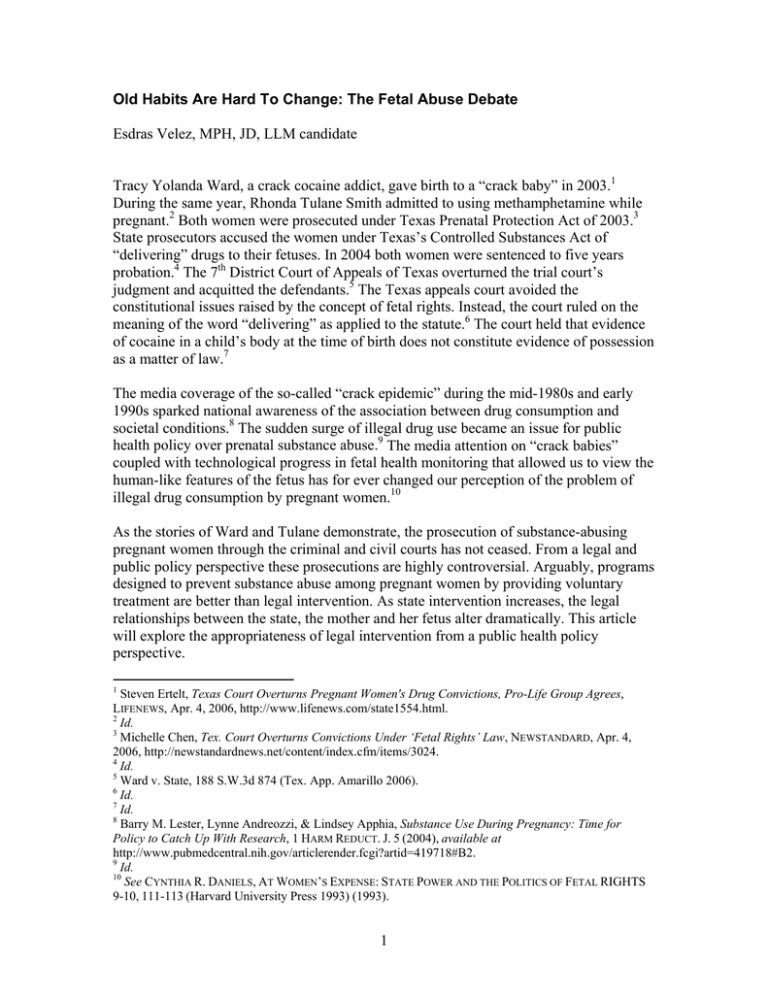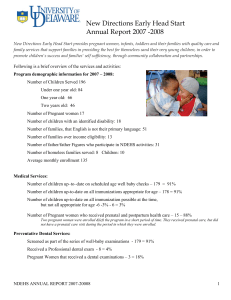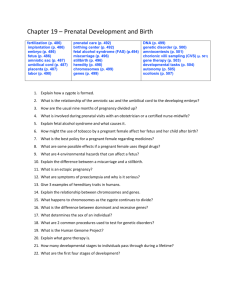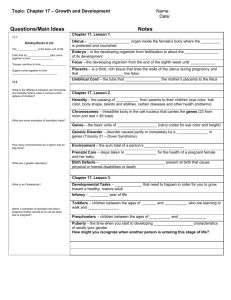Old Habits Are Hard To Change: The Fetal Abuse Debate
advertisement

Old Habits Are Hard To Change: The Fetal Abuse Debate Esdras Velez, MPH, JD, LLM candidate Tracy Yolanda Ward, a crack cocaine addict, gave birth to a “crack baby” in 2003.1 During the same year, Rhonda Tulane Smith admitted to using methamphetamine while pregnant.2 Both women were prosecuted under Texas Prenatal Protection Act of 2003.3 State prosecutors accused the women under Texas’s Controlled Substances Act of “delivering” drugs to their fetuses. In 2004 both women were sentenced to five years probation.4 The 7th District Court of Appeals of Texas overturned the trial court’s judgment and acquitted the defendants.5 The Texas appeals court avoided the constitutional issues raised by the concept of fetal rights. Instead, the court ruled on the meaning of the word “delivering” as applied to the statute.6 The court held that evidence of cocaine in a child’s body at the time of birth does not constitute evidence of possession as a matter of law.7 The media coverage of the so-called “crack epidemic” during the mid-1980s and early 1990s sparked national awareness of the association between drug consumption and societal conditions.8 The sudden surge of illegal drug use became an issue for public health policy over prenatal substance abuse.9 The media attention on “crack babies” coupled with technological progress in fetal health monitoring that allowed us to view the human-like features of the fetus has for ever changed our perception of the problem of illegal drug consumption by pregnant women.10 As the stories of Ward and Tulane demonstrate, the prosecution of substance-abusing pregnant women through the criminal and civil courts has not ceased. From a legal and public policy perspective these prosecutions are highly controversial. Arguably, programs designed to prevent substance abuse among pregnant women by providing voluntary treatment are better than legal intervention. As state intervention increases, the legal relationships between the state, the mother and her fetus alter dramatically. This article will explore the appropriateness of legal intervention from a public health policy perspective. 1 Steven Ertelt, Texas Court Overturns Pregnant Women's Drug Convictions, Pro-Life Group Agrees, LIFENEWS, Apr. 4, 2006, http://www.lifenews.com/state1554.html. 2 Id. 3 Michelle Chen, Tex. Court Overturns Convictions Under ‘Fetal Rights’ Law, NEWSTANDARD, Apr. 4, 2006, http://newstandardnews.net/content/index.cfm/items/3024. 4 Id. 5 Ward v. State, 188 S.W.3d 874 (Tex. App. Amarillo 2006). 6 Id. 7 Id. 8 Barry M. Lester, Lynne Andreozzi, & Lindsey Apphia, Substance Use During Pregnancy: Time for Policy to Catch Up With Research, 1 HARM REDUCT. J. 5 (2004), available at http://www.pubmedcentral.nih.gov/articlerender.fcgi?artid=419718#B2. 9 Id. 10 See CYNTHIA R. DANIELS, AT WOMEN’S EXPENSE: STATE POWER AND THE POLITICS OF FETAL RIGHTS 9-10, 111-113 (Harvard University Press 1993) (1993). 1 The policy response to the prenatal drug exposure phenomenon has occurred through either the criminal justice system or state legislature.11 Legislative responses can be categorized as punitive on the one hand or as public health-related on the other.12 Prosecutors have employed different strategies to hold pregnant women addicted to drugs criminally liable.13 For example, some have used laws that make it a crime to deliver drugs to minors by arguing that for a few minutes after birth the mother and the child remains attached to one another via the umbilical cord and that during that time drugs could be transferred from the mother to the baby.14 In this strategy, the objective seems to be deterrence of drug abuse through punishment. The public health approach, on the other hand, views addiction as a disease that is best treated as a medical condition. The Supreme Court has long recognized drug addiction as an illness and the need for those suffering from it as in need of medical treatment.15 This proposal utilizes a public health approach in trying to establish a policy directed toward the drug treatment needs of pregnant women. The conceptual framework is based on the Jacobson, Zellman and Fair notion of “Reciprocal Obligations” in which both the state and the pregnant woman have obligations to the fetus and to each other. The foundation of this framework is that if the woman decides not to terminate the pregnancy, both the state and the pregnant woman must act in the best interests of the fetus. Although the state has a legitimate interest in enhancing birth outcomes, it cannot intervene with impunity, since its actions must take into account the pregnant woman’s rights. Similarly, the pregnant woman cannot reject the state’s intervention by asserting her privacy rights to the exclusion of her obligations to the fetus. More important, our framework moves away from the conventional and highly problematic dichotomies between the maternal rights and fetal interests that frame much of the [prenatal substance exposure] PSE discourse. Instead of characterizing the issue as a maternal-fetal conflict, we substitute the framework of mutual obligations to optimize maternal and fetal/child health outcomes.16 The reciprocal obligations theory “presumes that carrying a pregnancy to term is a choice.”17 This assumption may raise a potential flaw in the theory since a pregnant drug user may have no other choice than to carry the baby to term due to lack of access to abortion facilities due to financial constraints. The authors acknowledge the difficulty in ascertaining whether an informed choice has really occurred. Reconciling the issue is 11 Jean Reith Schroedel & Pamela Fiber, Punitive Versus Public Health Oriented Responses to Drug Use by Pregnant Women, 1 YALE J. HEALTH POL’Y L. & ETHICS 217 (2001). 12 Id. (A discussion about punitive policies is beyond the scope of this article, which will focus on a nonpunitive health approach). 13 Id. 14 Id. 15 Robinson v. California, 370 U.S. 660 (1962). 16 Peter D. Jacobson, Gail L. Zellman and C. Christine Fair, Reciprocal Obligations: Managing Policy Responses to Prenatal Substance Exposure, 81 MILBANK Q. 475, 479 (2003). 17 Id. at 481. 2 difficult, but I agree with the authors that “as long as the pregnant woman continues to carry the fetus, she has made a choice that will have certain consequences if she continues to ingest illicit substances. And as the pregnancy moves along toward viability and being taken to term, that choice becomes clearer, as do the reciprocal obligations.”18 Under this framework the state’s interest in preventing prenatal drug exposure is to be considered in conjunction with the state’s obligation to address the needs of pregnant women.19 If the state decides to exercise its police power in order to protect fetuses from prenatal drug exposure and enhance the possibilities of a healthy baby at birth, then the state must provide these women “with adequate prenatal care and substance abuse treatment, paid for by the state when private insurance coverage is unaffordable or unavailable.”20 In other words, the state has an obligation that must be met in order to be in position to demand satisfaction of the reciprocal obligations as set forth under the theory. So, should a state adopt a policy geared toward penalizing pregnant women for failing to participate in drug treatment? Policy makers addressing maternal fetal conflicts need to weigh the potential benefits of the policy proposals against the costs to the parties involved (the pregnant woman, the fetus, and society).21 As a public health issue, no one questions the state’s interest in facilitating treatment of pregnant substance abusers. Proponents of mandatory treatment advocate that this type of action serves that interest, as well as the well-being of the mother and her fetus.22 Opponents emphasize the negative effects of limiting certain behaviors during a woman’s pregnancy. For example, a policy that criminalizes prenatal drug use or uses civil commitment for mandatory treatment will only serve as conduit for deterring women from seeking prenatal care.23 The fear of being turned in by their physicians may weigh heavily on women minds, thus impelling them to avoid needed health care.24 Lack of adequate prenatal care can result in health complications during pregnancy.25 So what should a legislative policy look like? I propose taking a public health perspective that takes into account the following: education, screening, intervention, and treatment.26 This multilayer approach tries to balance competing interests between the parties. 18 Id. at 482. Id. at 482. 20 Id. 21 Elizabeth L. Thompson, The Criminalization of Maternal Conduct During Pregnancy: A Decisionmaking Model for Lawmakers, 64 IND. L.J. 357, 365 (1988). 22 See Louise Marlane Chan, S.O.S. From the Womb: A Call for New York Legislation Criminalizing Drug Use During Pregnancy, 21 FORDHAM URB. L.J. 199 (1993); Christine Hunt, Criminalizing Prenatal Substance Abuse: A Preventative Means of Ensuring The Birth of a Drug-Free Child, 33 IDAHO L. REV. 451 (1997). 23 Wendy Chavkin, Mandatory Treatment for Drug Use During Pregnancy, 266 JAMA 1556, 1559 (1991). 24 Id. 25 Id. 26 Susan Fortney, A Jurisprudential Analysis of Government Intervention and Prenatal Drug Abuse, 17 J. L. & Health 11 (2002). 19 3 Education is indispensable if we are serious about preventing prenatal drug use. The school education system should incorporate seminars on drug addiction and its effects.27 Also, informational brochures can be made available by state health agencies in hospitals and physicians.28 Prevention of drug addiction before it begins is a strategy worth using. The second part of this comprehensive program entails the enactment of statues facilitating drug screening of pregnant women. Through out public health history screening has been recognized as a valid measure intended to safeguard the health and safety of the populace.29 Health professionals need to be aware of patient drug abuse in order to provide appropriate medical care. The health of both the patient and fetus can be compromised if physicians are uninformed of a patient’s drug abuse. Even though the American College of Obstetricians and Gynecologists maintain a policy that drug testing should be voluntary and informed,30 the reality is that maternal self-reporting is often unreliable; for example, a study of cocaine use during pregnancy revealed 24-63% of mothers with positive cocaine tests denied using cocaine.31 Prenatal screening programs in public health are nothing new. All states and the District of Columbia have enacted statutes or regulations requiring prenatal screening for specific health risks32 such as, for example, syphilis.33 In many cases a plethora of prenatal screens are performed without the woman being specifically informed of each one.34 Not only mothers are compelled to mandated prenatal screenings but newborns also are subject to such programs regarding, for example, phenylketonuria (PKU).35 Screening programs are essential instruments in public health .36 But these programs must weigh the benefits to an individual or the public against their potential harm.37 Considering the foregoing arguments, the policy calls for a universal screening approach by physicians, in which patients are notified of testing and their right to opt out, as a regular part of patient care. The adoption of a universal screening approach takes away targeted testing from the equation, thus eliminating potential discriminatory practices by physicians. Even though the proposed approach maintains a women’s right to decline testing, all women benefit from getting information on drug addiction and easy access to treatment. 27 Id. Id. 29 George J. Annas, Control of Tuberculosis – The Law and the Public’s Health, 328 NEW ENG. J. MED. 585 (1993). 30 American College of Obstetricians and Gynecologists, At-Risk Drinking and Illicit Drug Use: Ethical Issues in Obstetric and Gynecologic Practice, ACOG Committee Opinion No. 294, 103 OBSTET. GYNECOL. 1021 (2004). 31 Deborah A. Frank, et al., Cocaine Use During Pregnancy: Prevalence and Correlates, 82 PEDIATRICS 888 (1988). 32 Andrea Marsh, Testing Pregnant Women and Newborns for HIV: Legal and Ethical Responses to Public Health Efforts to Prevent Pediatric AIDS, 13 YALE J.L. & FEMINISM 195, 223 (2001). 33 Id. 34 Id. 35 Id. 36 Id. 37 Id. 28 4 The third part of this comprehensive program focuses on intervention. Trained health professionals in drug abuse counseling are better qualified to deal with the specific needs of pregnant women drug users.38 Once notified, these public health professionals will contact women who test positive with their test results and counsel them on treatment options.39 Constitutional issues such as bodily integrity need to be addressed in determining whether treatment should be mandatory or not. A pregnant woman is in a peculiar situation under the law. On the one hand, a competent pregnant woman can refuse medical treatment, while on the other the state has vested interest in the potential life of the fetus since the moment of conception.40 Case law dealing with compelled medical treatment over a pregnant woman’s objection is not as clear as cases concerning nonpregnant competent adults.41 Some courts have concluded that a pregnant woman’s constitutional rights are not violated when compelled medical treatment is intended to benefit her fetus, thus forcing these women to submit to unwanted treatment.42 In reaching such conclusions, courts have balanced the mother's interest in rejecting medical treatment against the state's interest in the potential life of the fetus. Not surprisingly, these courts have concluded that the state's interest in fetal health trumps the pregnant woman's interest in refusing treatment.43 On the other hand, other courts have rejected the applicability of this balancing test and ruled that pregnant women have the same rights as non-pregnant women to refuse any medical intervention as long as they are competent to do so.44 Under this analysis, a pregnant woman’s constitutional rights of privacy and bodily integrity outweigh the state's interest in fetal life.45 Quarantining or isolating a pregnant woman during her pregnancy until the baby is born seems to be excessive and the costs to do so would be high. Public health officials tend to civilly commit patients as a measure of last resort. Contrary to its use in the case of tuberculosis and other contagious diseases, confinement of a pregnant substance abuser is difficult to justify in view of the fact that tuberculosis is airborne and drug dependency is not. In addition, issues such as a pregnant woman’s unwillingness to seek prenatal care from fear of being discriminated against, stigmatized, and incarcerated need to be addressed. Encouraging pregnant women to seek testing and treatment accordingly seems to be a more reasonable public health policy rather than compel these women to submit to both. 38 See Fortney, supra note 26. Id. 40 Planned Parenthood of Southeastern Pa. v. Casey, 505 U.S. 833, 869 (1992). 41 Peta Lewis Hallisey, The Fetal Patient and the Unwilling Mother: A Standard for Judicial Intervention, 14 PAC. L.J. 1065, 1092 (1983). 42 Jefferson v. Griffin Spalding County Hosp. Auth., 274 S.E.2d 457 (Ga. 1981); In re Jamaica Hosp., 491 N.Y.S.2d 898 (N.Y. Sup. Ct. 1985). 43 See, e.g., Jefferson, 274 S.E.2d at 460. 44 See, e.g., In re Baby Boy Doe, 632 N.E.2d 326 (Ill. App. Ct. 1994). 45 Lawrence J. Nelson et al., Forced Medical Treatment of Pregnant Women: "Compelling Each to Live as Seems Good to the Rest," 37 HASTINGS L.J. 703, 757 (1986). 39 5 After screening and intervention, treatment is the last phase in the program. Drug addiction experts report that treatment in order to be effective needs to be comprehensive by combining both psychological and pharmacological therapies in conjunction with social service interventions.46 Government commitment guaranteeing access and adequate treatment facilities is indispensable if the program is to work. A comprehensive policy such as the foregoing is worth exploring if we are really serious about preventing prenatal drug exposure. April 2007 46 Steven Stocker, Drug Addiction Treatment Conference Emphasizes Combining Therapies, NIDA NOTES, available at http://www.nida.nih.gov/NIDA_Notes/NNVol13n3/combining.html. 6







